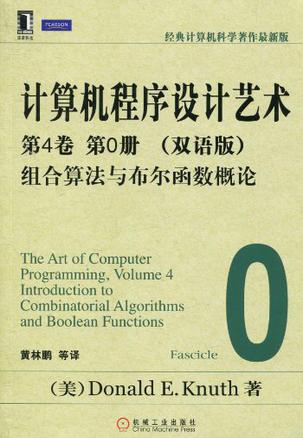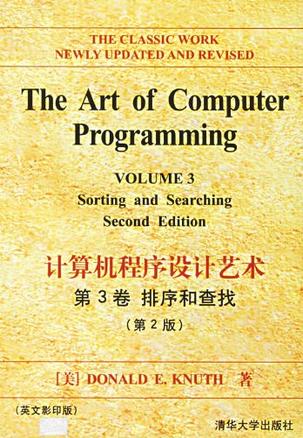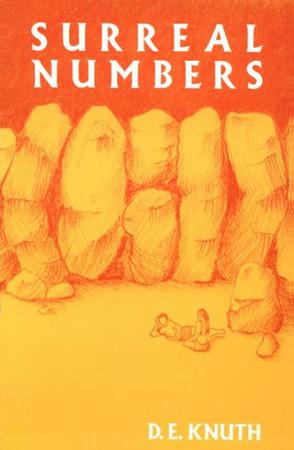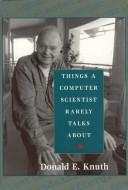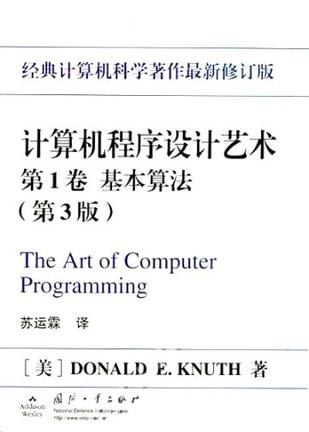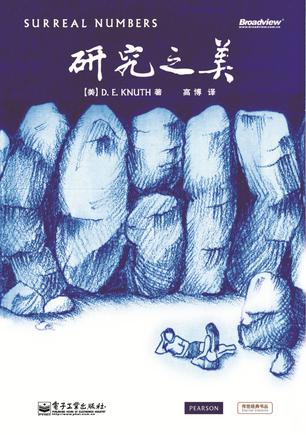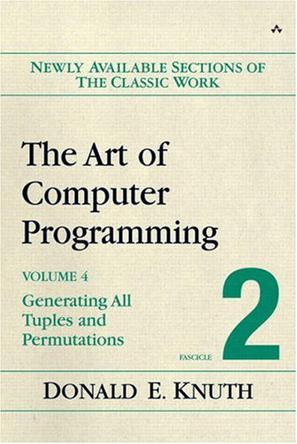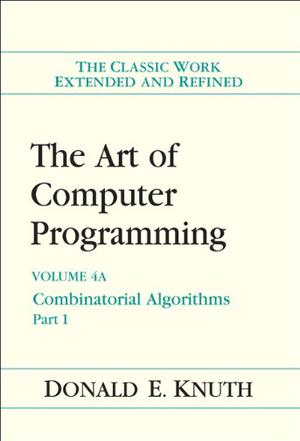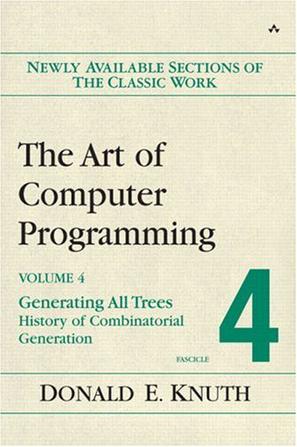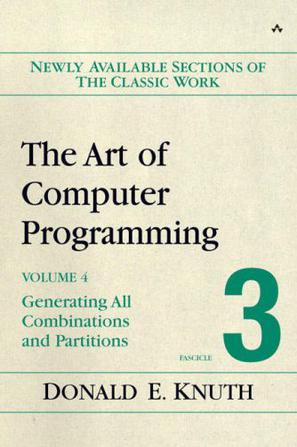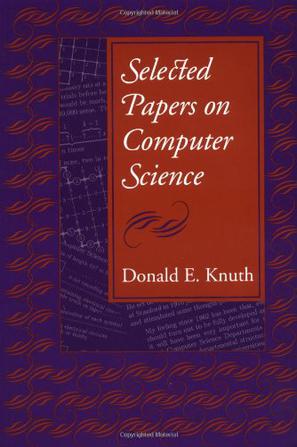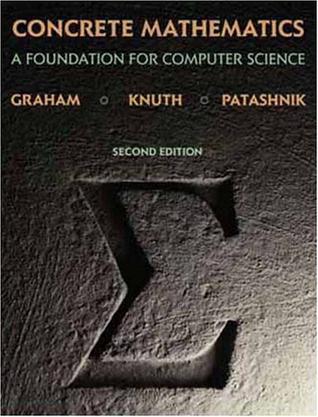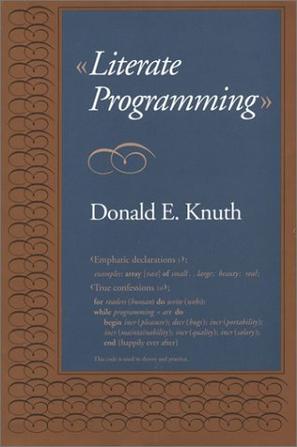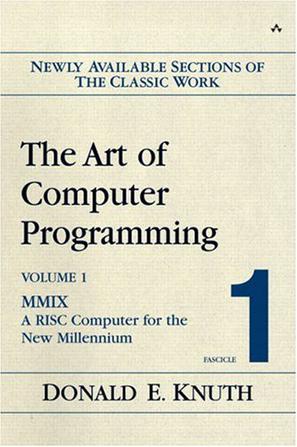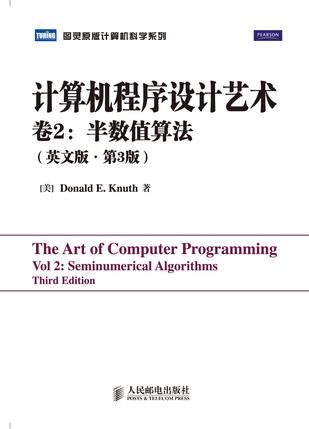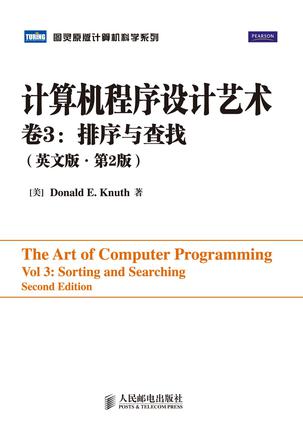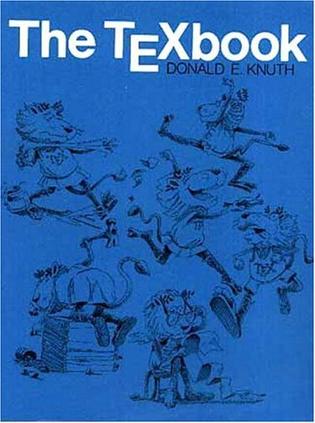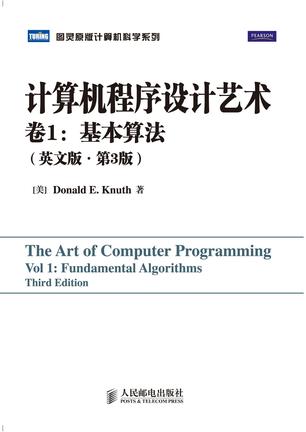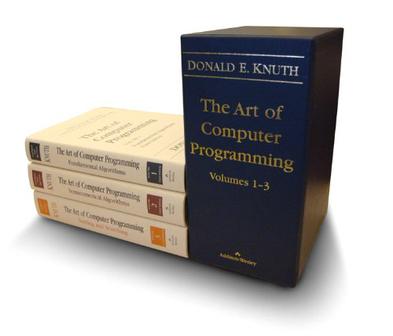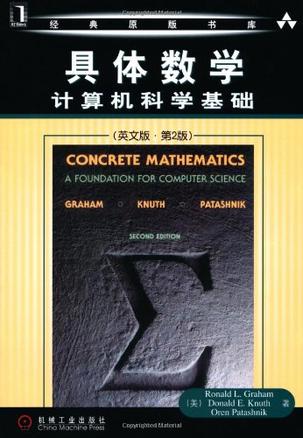欢迎来到相识电子书!
标签:Knuth
-
计算机程序设计艺术
《计算机程序设计艺术(第4卷·第0册):组合算法与布尔函数概论(双语版)》是《计算机程序设计艺术,第4卷:组合算法》的第0册。《计算机程序设计艺术(第4卷·第0册):组合算法与布尔函数概论(双语版)》介绍了组合搜索历史和演化,涉及组合搜索技术的理论和实践应用,探究了布尔函数相关的所有重要问题,考察了如何最有效地计算一个布尔函数的值的技术。本册是《计算机程序设计艺术的》第7章,即组合搜索一长篇宏论的起始。 -
计算机程序设计艺术(第3卷)-排序和查找(英文影印版)
《计算机程序设计艺术排序和查找(第3卷)(第2版)》内容简介:这是对第3卷的头一次修订,不仅是对经典计算机排序和查找技术的最全面介绍,而且还对第1卷中的数据结构处理技术作了进一步的扩充,通盘考虑了将大小型数据库和内外存储器。它遴选了一些经过反复检验的计算机方法,并对其效率做了定量分析。第3卷的突出特点是对“最优排序”一节作了修订,对排列论原理与通用散列法作了全新讨论。 -
Surreal Numbers
From the Back Cover Nearly 30 years ago, John Horton Conway introduced a new way to construct numbers. Donald E. Knuth, in appreciation of this revolutionary system, took a week off from work on The Art of Computer Programming to write an introduction to Conway's method. Never content with the ordinary, Knuth wrote this introduction as a work of fiction--a novelette. If not a steamy romance, the book nonetheless shows how a young couple turned on to pure mathematics and found total happiness. The book's primary aim, Knuth explains in a postscript, is not so much to teach Conway's theory as "to teach how one might go about developing such a theory." He continues: "Therefore, as the two characters in this book gradually explore and build up Conway's number system, I have recorded their false starts and frustrations as well as their good ideas. I wanted to give a reasonably faithful portrayal of the important principles, techniques, joys, passions, and philosophy of mathematics, so I wrote the story as I was actually doing the research myself."... It is an astonishing feat of legerdemain. An empty hat rests on a table made of a few axioms of standard set theory. Conway waves two simple rules in the air, then reaches into almost nothing and pulls out an infinitely rich tapestry of numbers that form a real and closed field. Every real number is surrounded by a host of new numbers that lie closer to it than any other "real" value does. The system is truly "surreal." quoted from Martin Gardner, Mathematical Magic Show, pp. 16--19 Surreal Numbers, now in its 13th printing, will appeal to anyone who might enjoy an engaging dialogue on abstract mathematical ideas, and who might wish to experience how new mathematics is created. -
Things a Computer Scientist Rarely Talks About
How does a computer scientist understand infinity? What can probability theory teach us about free will? Can mathematical notions be used to enhance one's personal understanding of the Bible? Perhaps no one is more qualified to address these questions than Donald E. Knuth, whose massive contributions to computing have led others to nickname him "The Father of Computer Science"--and whose religious faith led him to understand a fascinating analysis of the Bible called the 3:16 project. In this series of six spirited, informal lectures, Knuth explores the relationships between his vocation and his faith, revealing the unique perspective that his work with computing has lent to his understanding of God. His starting point is the 3:16 project, an application of mathematical "random sampling" to the books of the Bible. The first lectures tell the story of the project's conception and execution, exploring its many dimensions of language translation, aesthetics, and theological history. Along the way, Knuth explains the many insights he gained from such interdisciplinary work. These theological musings culminate in a surprising final lecture tackling the ideas of infinity, free will, and some of the other big questions that lie at the juncture of theology and computation. Things a Computer Scientist Rarely Talks About, with its charming and user-friendly format--each lecture ends with a question and answer exchange, and the book itself contains more than 100 illustrations--is a readable and intriguing approach to a crucial topic, certain to edify both those who are serious and curious about their faiths and those who look at the science of computation and wonder what it might teach them about their spiritual world. Includes "Creativity, Spirituality, and Computer Science," a panel discussion featuring Harry Lewis, Guy L. Steele, Jr., Manuela Veloso, Donald E. Knuth, and Mitch Kapor. -
计算机程序设计艺术(第1卷)
7卷本《计算机程序设计艺术》的第1卷以基本的程序设计概念和技术开始,然后专注于信息结构——计算机内部信息的表示、数据元素之间的结构关系以及如何有效地处理它们,给出了对于模拟、数值方法、符号计算、软件和系统设计的初等应用。书中附有大量习题和答案,标明了难易程序及数学概念的使用。 此新版本增加了几十项简单且重要的算法和技术,并对有关数学预备知识作了大量修改以适应现时研究的趋势。 -
研究之美
《研究之美》是计算机科学大师、“算法分析之父”高德纳(Donald E.Knuth)在20世纪70年代旅居挪威时撰写的适用于计算机科学的一种全新基础数学结构的情景小品。全书以一对追求自由精神生活的青年男女为主人公,展开了一段对于该种全新结构的发现和构造的对白。在此过程中,本书充分展示了计算机科学的从业人员进行全新领域探索时所必备的怀疑、立论、构造、证明、归纳、演绎等逻辑推理和深入反思的能力。《研究之美》可以看作是读懂高德纳的艰深著作《计算机程序设计艺术》和《具体数学》的钥匙。 -
The Art of Computer Programming, Volume 4, Fascicle 2
From the Back Cover This multivolume work on the analysis of algorithms has long been recognized as the definitive description of classical computer science. The three complete volumes published to date already comprise a unique and invaluable resource in programming theory and practice. Countless readers have spoken about the profound personal influence of Knuth's writings. Scientists have marveled at the beauty and elegance of his analysis, while practicing programmers have successfully applied his "cookbook" solutions to their day-to-day problems. All have admired Knuth for the breadth, clarity, accuracy, and good humor found in his books. To begin the fourth and later volumes of the set, and to update parts of the existing three, Knuth has created a series of small books called fascicles, which will be published t regular intervals. Each fascicle will encompass a section or more of wholly new or evised material. Ultimately, the content of these fascicles will be rolled up into the comprehensive, final versions of each volume, and the enormous undertaking that began in 1962 will be complete. Volume 4, Fascicle 2 This fascicle inaugurates the eagerly awaited publication of Knuth's The Art of Computer Programming, Volume 4: Combinatorial Algorithms. Part of what will be a long chapter on combinatorial searching, the fascicle begins his treatment of how to generate all possibilities. Specifically, it discusses the generation of all n-tuples, then extends those ideas to all permutations. Such algorithms provide a natural motivation by means of which many of the key ideas of combinatorial mathematics can be introduced and explored. In this and other fascicles of Volume 4, Knuth illuminates important theories by discussing related games and puzzles. Even serious programming can be fun. -
The Art of Computer Programming, Volume 4A
The book is Volume 4A, because Volume 4 has itself become a multivolume undertaking. Combinatorial searching is a rich and important topic, and Knuth has too much to say about it that is new, interesting, and useful to fit into a single volume, or two, or maybe even three. This book alone includes approximately 1500 exercises, with answers for self-study, plus hundreds of useful facts that cannot be found in any other publication. Volume 4A surely belongs beside the first three volumes of this classic work in every serious programmer’s library. -
The Art of Computer Programming, Fascicle 4
Finally, after a wait of more than thirty-five years, the first part of Volume 4 is at last ready for publication. Check out the boxed set that brings together Volumes 1 - 4A in one elegant case, and offers the purchaser a $50 discount off the price of buying the four volumes individually. The Art of Computer Programming, Volumes 1-4A Boxed Set, 3/e ISBN: 0321751043 Art of Computer Programming, Volume 4, Fascicle 4,The: Generating All Trees--History of Combinatorial Generation: Generating All Trees--History of Combinatorial Generation This multivolume work on the analysis of algorithms has long been recognized as the definitive description of classical computer science.The three complete volumes published to date already comprise a unique and invaluable resource in programming theory and practice. Countless readers have spoken about the profound personal influence of Knuth's writings. Scientists have marveled at the beauty and elegance of his analysis, while practicing programmers have successfully applied his “cookbook” solutions to their day-to-day problems. All have admired Knuth for the breadth, clarity, accuracy, and good humor found in his books. To begin the fourth and later volumes of the set, and to update parts of the existing three, Knuth has created a series of small books called fascicles, which will be published at regular intervals. Each fascicle will encompass a section or more of wholly new or revised material. Ultimately, the content of these fascicles will be rolled up into the comprehensive, final versions of each volume, and the enormous undertaking that began in 1962 will be complete. Volume 4, Fascicle 4 This latest fascicle covers the generation of all trees, a basic topic that has surprisingly rich ties to the first three volumes of The Art of Computer Programming. In thoroughly discussing this well-known subject, while providing 124 new exercises, Knuth continues to build a firm foundation for programming. To that same end, this fascicle also covers the history of combinatorial generation. Spanning many centuries, across many parts of the world, Knuth tells a fascinating story of interest and relevance to every artful programmer, much of it never before told. The story even includes a touch of suspense: two problems that no one has yet been able to solve. -
The Art of Computer Programming, Volume 4, Fascicle 3
Finally, after a wait of more than thirty-five years, the first part of Volume 4 is at last ready for publication. Check out the boxed set that brings together Volumes 1 - 4A in one elegant case, and offers the purchaser a $50 discount off the price of buying the four volumes individually. The Art of Computer Programming, Volumes 1-4A Boxed Set, 3/e ISBN: 0321751043 Art of Computer Programming, Volume 4, Fascicle 3, The: Generating All Combinations and Partitions: Generating All Combinations and Partitions This multivolume work on the analysis of algorithms has long been recognized as the definitive description of classical computer science.The three complete volumes published to date already comprise a unique and invaluable resource in programming theory and practice. Countless readers have spoken about the profound personal influence of Knuth's writings. Scientists have marveled at the beauty and elegance of his analysis, while practicing programmers have successfully applied his "cookbook" solutions to their day-to-day problems. All have admired Knuth for the breadth, clarity, accuracy, and good humor found in his books. To begin the fourth and later volumes of the set, and to update parts of the existing three, Knuth has created a series of small books called fascicles, which will be published at regular intervals. Each fascicle will encompass a section or more of wholly new or revised material. Ultimately, the content of these fascicles will be rolled up into the comprehensive, final versions of each volume, and the enormous undertaking that began in 1962 will be complete. Volume 4, Fascicle 3 This fascicle continues Knuth's authoritative chapter on combinatorial algorithms, ultimately to be included in Volume 4 of The Art of Computer Programming. The previous fascicle from Volume 4, which covered the generation of all tuples and permutations, is now complemented by techniques for generating all combinations and partitions. In Knuth's thorough discussion of these two topics, readers will find much that is new, as well as surprisingly rich ties to material in Volumes 1 through 3 and to other aspects of computer science and mathematics. As usual, this fascicle includes a bounty of creative exercises, as well as intriguing challenges posed by yet-unsolved questions. -
Concrete Mathematics
This book introduces the mathematics that supports advanced computer programming and the analysis of algorithms. The primary aim of its well-known authors is to provide a solid and relevant base of mathematical skills - the skills needed to solve complex problems, to evaluate horrendous sums, and to discover subtle patterns in data. It is an indispensable text and reference not only for computer scientists - the authors themselves rely heavily on it! - but for serious users of mathematics in virtually every discipline. Concrete Mathematics is a blending of CONtinuous and disCRETE mathematics. "More concretely," the authors explain, "it is the controlled manipulation of mathematical formulas, using a collection of techniques for solving problems." The subject matter is primarily an expansion of the Mathematical Preliminaries section in Knuth's classic Art of Computer Programming, but the style of presentation is more leisurely, and individual topics are covered more deeply. Several new topics have been added, and the most significant ideas have been traced to their historical roots. The book includes more than 500 exercises, divided into six categories.Complete answers are provided for all exercises, except research problems, making the book particularly valuable for self-study. Major topics include: *Sums *Recurrences *Integer functions *Elementary number theory *Binomial coefficients *Generating functions *Discrete probability *Asymptotic methods This second edition includes important new material about mechanical summation. In response to the widespread use of the first edition as a reference book, the bibliography and index have also been expanded, and additional nontrivial improvements can be found on almost every page. Readers will appreciate the informal style of Concrete Mathematics. Particularly enjoyable are the marginal graffiti contributed by students who have taken courses based on this material. The authors want to convey not only the importance of the techniques presented, but some of the fun in learning and using them. 0201558025B04062001 -
Literate Programming (Center for the Study of Language and Information - Lecture Notes)
Literate programming is a programming methodology that combines a programming language with a documentation language, making programs more robust, more portable, and more easily maintained than programs written only in a high-level language. Computer programmers already know both kinds of languages; they need only learn a few conventions about alternating between languages to create programs that are works of literature. A literate programmer is an essayist who writes programs for humans to understand, instead of primarily writing instructions for machines to follow. When programs are written in the recommended style they can be transformed into documents by a document compiler and into efficient code by an algebraic compiler. This anthology of essays from the inventor of literate programming includes Knuth's early papers on related topics such as structured programming, as well as the Computer Journal article that launched literate programming itself. -
The Art of Computer Programming, Volume 1, Fascicle 1
From the Back Cover This multivolume work on the analysis of algorithms has long been recognized as the definitive description of classical computer science. The three complete volumes published to date already comprise a unique and invaluable resource in programming theory and practice. Countless readers have spoken about the profound personal influence of Knuth's writings. Scientists have marveled at the beauty and elegance of his analysis, while practicing programmers have successfully applied his "cookbook" solutions to their day-to-day problems. All have admired Knuth for the breadth, clarity, accuracy, and good humor found in his books. To begin the fourth and later volumes of the set, and to update parts of the existing three, Knuth has created a series of small books called fascicles, which will be published t regular intervals. Each fascicle will encompass a section or more of wholly new or evised material. Ultimately, the content of these fascicles will be rolled up into the comprehensive, final versions of each volume, and the enormous undertaking that began in 1962 will be complete. Volume 1, Fascicle 1 This first fascicle updates The Art of Computer Programming, Volume 1, Third Edition: Fundamental Algorithms, and ultimately will become part of the fourth edition of that book. Specifically, it provides a programmer's introduction to the long-awaited MMIX, a RISC-based computer that replaces the original MIX, and describes the MMIX assembly language. The fascicle also presents new material on subroutines, coroutines, and interpretive routines. -
计算机程序设计艺术(第2卷 英文版·第3版)
《计算机程序设计艺术》系列著作对计算机领域产生了深远的影响。这一系列堪称一项浩大的工程,自1962年开始编写,计划出版7卷,目前已经出版了4卷。《美国科学家》杂志曾将这套书与爱因斯坦的《相对论》等书并列称为20世纪最重要的12本物理学著作。目前Knuth正将毕生精力投入到这部史诗性著作的撰写中。想了解本书最新信息,请访http://www-cs-faculty.stanford.edu/~knuth/taocp.html。 -
计算机程序设计艺术(第3卷 英文版·第2版)
《计算机程序设计艺术》系列被公认为计算机科学领域的权威之作,深入阐述了程序设计理论,对计算机领域的发展有着极为深远的影响。本书是该系列的第3卷,扩展了第1卷中信息结构的内容,主要讲排序和查找。书中对排序和查找算法进行了详细的介绍,并对各种算法的效率做了大量的分析。 本书适合从事计算机科学、计算数学等各方面工作的人员阅读,也适合高等院校相关专业的师生作为教学参考书,对于想深入理解计算机算法的读者,是一份必不可少的珍品。 -
TeXbook
TeX 排版系统的权威指南。 -
计算机程序设计艺术卷1:基本算法(英文版.第3版)
《计算机程序设计艺术》系列著作对计算机领域产生了深远的影响。这一系列堪称一项浩大的工程,自1962年开始编写,计划出版7卷,目前已经出版了4卷。《美国科学家》杂志曾将这套书与爱因斯坦的《相对论》等书并列称为20世纪最重要的12本物理学著作。目前Knuth正将毕生精力投入到这部史诗性著作的撰写中。想了解本书最新信息,请访http://www-cs-faculty.stanford.edu/~knuth/taocp.html。 -
The Art of Computer Programming, Volumes 1-3 Boxed Set
This multivolume work is widely recognized as the definitive description of classical computer science. The first three volumes have for decades been an invaluable resource in programming theory and practice for students, researchers, and practitioners alike. The bible of all fundamental algorithms and the work that taught many of today's software developers most of what they know about computer programming. --Byte, September 1995 Countless readers have spoken about the profound personal influence of Knuth's work. Scientists have marveled at the beauty and elegance of his analysis, while ordinary programmers have successfully applied his "cookbook" solutions to their day-to-day problems. All have admired Knuth for the breadth, clarity, accuracy, and good humor found in his books. I can't begin to tell you how many pleasurable hours of study and recreation they have afforded me! I have pored over them in cars, restaurants, at work, at home! and even at a Little League game when my son wasn't in the line-up. --Charles Long Primarily written as a reference, some people have nevertheless found it possible and interesting to read each volume from beginning to end.A programmer in China even compared the experience to reading a poem. If you think you're a really good programmer! read [Knuth's] Art of Computer Programming! You should definitely send me a resume if you can read the whole thing. --Bill Gates Whatever your background, if you need to do any serious computer programming, you will find your own good reason to make each volume in this series a readily accessible part of your scholarly or professional library. It's always a pleasure when a problem is hard enough that you have to get the Knuths off the shelf. I find that merely opening one has a very useful terrorizing effect on computers. --Jonathan Laventhol For the first time in more than 20 years, Knuth has revised all three books to reflect more recent developments in the field. His revisions focus specifically on those areas where knowledge has converged since publication of the last editions, on problems that have been solved, on problems that have changed. In keeping with the authoritative character of these books, all historical information about previous work in the field has been updated where necessary.Consistent with the author's reputation for painstaking perfection, the rare technical errors in his work, discovered by perceptive and demanding readers, have all been corrected. Hundreds of new exercises have been added to raise new challenges. 0201485419B04062001 -
具体数学(英文版第2版)
This book introduces the mathematics that supports advanced computer Programming and the analysis of algorithms. The primary aim of its well-known authors is to provide a solid and relevant base of mathematical skills--the skills needed to solve complex problems, to evaluate horrendous sums, and to discover subtle Patterns in data. It is an indispensable text and reference not only for computer scientists--the authors themselves rely heavily on it! but for serious users Of mathematics in virtually every discipline. Concrete mathematics is a blending of continuous and disCRETE mathematics: "More concretely," the authors explain, "it is the controlled manipulation of mathematical formulas,using a collection of techniques for solving problems." The subject mater is primarily an expansion of the Mathematical Preliminaries section in Knuth's c1assic Art of Computer Programming, but the style of presentation is more leisurely, and individual topics are covered more deeply. Several new topics have been added, and the most significant ideas have been traced to their historical roots. The book includes more than 500 exercises, divided into six categories. Complete answers are provided for all exercises, except research problems, making the book particularly valuable for self-study.
热门标签
下载排行榜
- 1 梦的解析:最佳译本
- 2 李鸿章全传
- 3 淡定的智慧
- 4 心理操控术
- 5 哈佛口才课
- 6 俗世奇人
- 7 日瓦戈医生
- 8 笑死你的逻辑学
- 9 历史老师没教过的历史
- 10 1分钟和陌生人成为朋友

